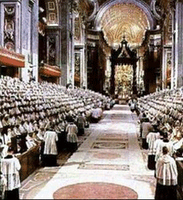Saturday, August 19, 2006
 The classic Vatican II definition of the Church, a complexity beyond a simple expression of hierarchy, social structures, and mystic reality in God. First, the witness of the recent popes:
The classic Vatican II definition of the Church, a complexity beyond a simple expression of hierarchy, social structures, and mystic reality in God. First, the witness of the recent popes:
Christ, the one Mediator, established and continually sustains here on earth His holy Church, the community of faith, hope and charity, as an entity with visible delineation (Leo XIII, Litt. Encycl. Sapientiae christianae, 10 ian. 1890 AAS 22 (1889-90) p. 392. Id., Epist. Encycl. Satis cognitium, 29 iun. 1896; AAS 28 (1895-96) pp. 710 ct 724 ss. Pius XII, Litt. Eneyel. Mystici Corporis, 1. c., pp. 199-200.) through which He communicated truth and grace to all. But, the society structured with hierarchical organs and the Mystical Body of Christ, are not to be considered as two realities, nor are the visible assembly and the spiritual community, nor the earthly Church and the Church enriched with heavenly things; rather they form one complex reality which coalesces from a divine and a human element.(Cfr. Pius XII, Litt. Encycl. Mystici Corporis, 1. c., p. 221 ss. Id., Lin. Encycl. Humani genesis, 12 Aug. 1950: AAS 42 (1950) p. 571.) For this reason, by no weak analogy, it is compared to the mystery of the incarnate Word. As the assumed nature inseparably united to Him, serves the divine Word as a living organ of salvation, so, in a similar way, does the visible social structure of the Church serve the Spirit of Christ, who vivifies it, in the building up of the body.(Cf. Eph. 4, 16) (Leo XIII, Epist. Encycl. Satis cognitum, 1. c., p. 713.)
And the witness of the early Church, including that mysterious and often debated principle of subsistence. What does it mean?
This is the one Church of Christ which in the Creed is professed as one, holy, catholic and apostolic, (Cfr. Symbolum Apostolicum: Denz. 6-9 (10-13); Symb. Nic.-Const.: Denz. 86 (150), coll. Prof. fidei Trid.: Denz. 994 et 999 (1862 et 1868).) which our Saviour, after His Resurrection, commissioned Peter to shepherd,(Jn. 21, 17) and him and the other apostles to extend and direct with authority,(Cf. Mt. 28, 18, f) which He erected for all ages as "the pillar and mainstay of the truth".(1 Tim. 3, 15) This Church constituted and organized in the world as a society, subsists in the Catholic Church, which is governed by the successor of Peter and by the Bishops in communion with him,(Dieitur. Saneta (catholica apostolica) Romana Ecelesia .: in Prof. fidei Trid., 1. c. et Concl. Vat. I, Sess. III, Const. dogm. de fide cath.: Denz. 1782 (3001).) although many elements of sanctification and of truth are found outside of its visible structure. These elements, as gifts belonging to the Church of Christ, are forces impelling toward catholic unity.
And some clarification about the mission of the Church. Recalling that Gaudium et Spes is still a year away from promulgation, we get a clear teaching on whom the Church associates with, namely Christ, on his path with the poor, the humble, the lost, the suffering, the sinners:
Just as Christ carried out the work of redemption in poverty and persecution, so the Church is called to follow the same route that it might communicate the fruits of salvation to (all people). Christ Jesus, "though He was by nature God . . . emptied Himself, taking the nature of a slave",(Phil. 2, 6) and "being rich, became poor"(2 Cor. 8, 9) for our sakes. Thus, the Church, although it needs human resources to carry out its mission, is not set up to seek earthly glory, but to proclaim, even by its own example, humility and selfsacrifice. Christ was sent by the Father "to bring good news to the poor, to heal the contrite of heart",(Lk. 4, 18) "to seek and to save what was lost".(Lk. 19, 10) Similarly, the Church encompasses with love all who are afflicted with human suffering and in the poor and afflicted sees the image of its poor and suffering Founder. It does all it can to relieve their need and in them it strives to serve Christ. While Christ, holy, innocent and undefiled(Hebr. 7, 26) knew nothing of sin,(2 Cor. 5, 21) but came to expiate only the sins of the people,(Cf. Hebr. 2, 17) the Church, embracing in its bosom sinners, at the same time holy and always in need of being purified, always follows the way of penance and renewal. The Church, "like a stranger in a foreign land, presses forward amid the persecutions of the world and the consolations of God"(S. Augustinus, Civ. Dei, XVIII, 51, 2: PL 41, 614.), announcing the cross and death of the Lord until He comes."(Cf. 1 Cor. 11,26) By the power of the risen Lord it is given strength that it might, in patience and in love, overcome its sorrows and its challenges, both within itself and from without, and that it might reveal to the world, faithfully though darkly, the mystery of its Lord until, in the end, it will be manifested in full light.